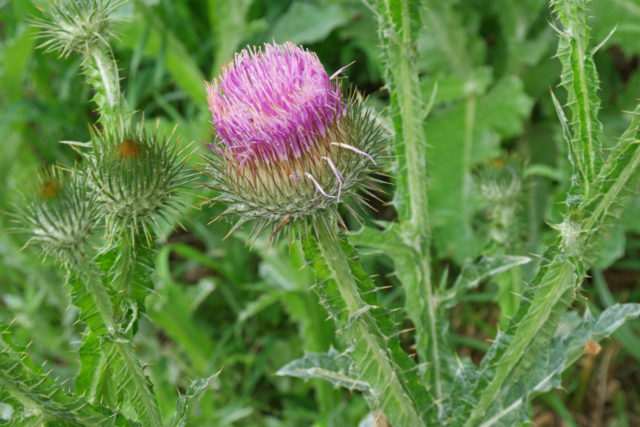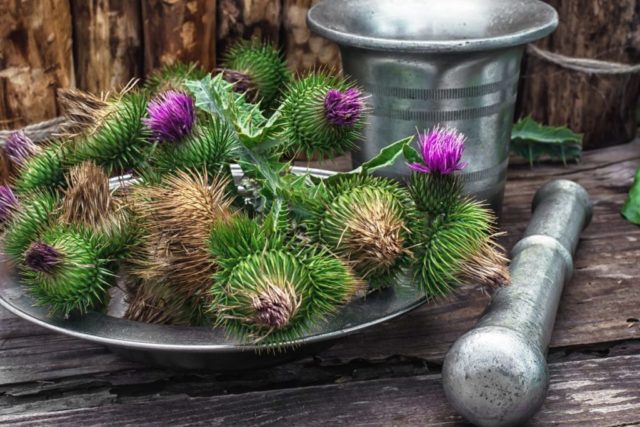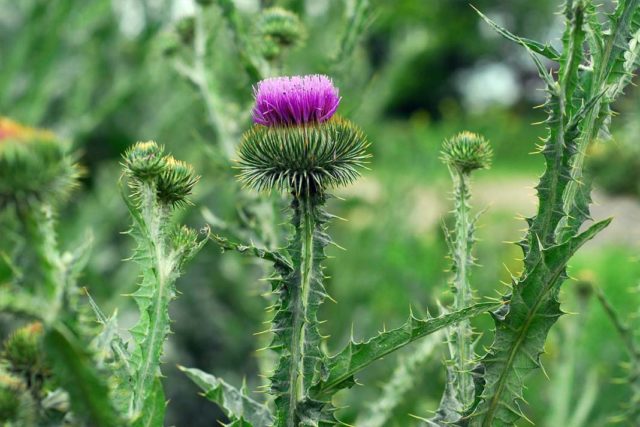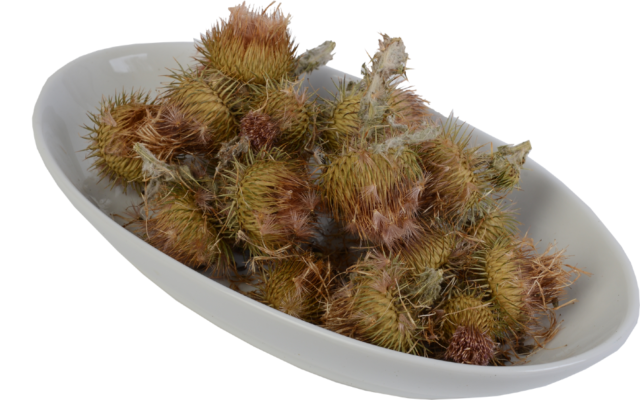Content
The prickly tartar (Onopordum acanthium) is a two-year-old large plant from the Astrov family. It is popularly called "thistle" or donkey thorn. Unpretentious, widespread throughout the Eurasian continent, in the northern regions of Africa, as well as in the Canary Islands. The healing properties and contraindications to prickly tartar have been familiar to healers for a long time. The plant is widely used in medicinal teas and teas for the treatment and prevention of a number of diseases.
The chemical composition of the prickly tartar
Serious laboratory studies of the prickly tartar have not been carried out, therefore its exact chemical composition has not been determined. It is known that its parts contain the following beneficial substances:
- up to 35% of fatty oils in seeds;
- alkaloids and sesquiterpene lactones with a strong antimicrobial and antifungal effect - in leaves and stems;
- vitamin C and the natural prebiotic inulin;
- flavonoids, coumarins and saponins.
Due to the high concentration of biologically active compounds, the tartar rightly occupies a leading position among other medicinal plants. It helps to heal the body and restore the work of internal organs during the rehabilitation period.
The use of the prickly tartar
Tartar herb has excellent medicinal properties:
- tones, invigorates, restores the body after a long illness;
- normalizes the work of the cardiovascular system, accelerates blood flow and increases blood pressure;
- stops bleeding, relieves cramps;
- has a bactericidal and fungicidal effect;
- gives a diuretic and astringent effect;
- used as an anti-inflammatory agent.
Tartar prickly is able to increase the tone of smooth muscles, it is used to treat a number of skin diseases.

Harm of the prickly tartar
Preparations based on this plant are low-toxic, do not have pronounced side effects. In small quantities, herbal decoctions act as a stimulant on the central nervous system, which can lead to increased excitability and insomnia. In case of an overdose, the following negative symptoms may occur:
- increased blood pressure;
- drowsiness, lethargy;
- strong heartbeat.
Contraindications to the tartar
The prickly tartar has practically no restrictions on admission. With caution, it should be used as a medicine for hypertensive patients, monitoring blood pressure readings. The body's reaction should be monitored by persons who have had a heart attack, with heart failure and thinned blood vessels.
Rules for the use of prickly tartar
For medicinal needs, flower cones and stems with leaves are used.You can use freshly cut or pre-dried raw materials. In the summer, you can use the freshly squeezed juice of the plant, for example, to treat sinusitis, instilling 3-4 drops in each nostril twice a day. The course of treatment is 10 days.
For cleansing and restoring tea, you need to prepare:
- 30 g flower baskets;
- 500 ml of water.
Boil the water, put the flowers in a thermos and pour boiling water over it. Insist night. Drink in between meals, 150-200 ml. There are no restrictions on the duration of the course.
With reduced pressure, the collection of tartar herb in the amount of 35 g and 10 g of the following medicinal plants helps:
- yarrow flowers;
- birch leaf;
- elecampane root;
- plantain leaves;
- nettle leaves;
- mint;
- ivy-shaped burda.
Pour 5 tbsp into 0.5 liters of boiling water. l. herbal mixture, simmer in a water bath for half an hour. Consume 40 ml 4 times a day.

The use of the prickly tartar
The area of application of the prickly tartar is very extensive. It effectively helps with the following ailments:
- cystitis, pyelonephritis, nephritis;
- cancers - uterine fibroids, endometritis, skin cancer, lupus;
- the recovery period after operations to remove cancerous tumors, chemotherapy, laser, prevention of the formation of metastases;
- stomach ulcer;
- a cough of a viral or bacterial nature;
- disturbed metabolism, salt deposits;
- reduced immunity;
- low blood pressure, impaired blood circulation;
- eczema, psoriasis, purulent wounds and acne, boils;
- dermatitis, lichen, scabies;
- weakened cardiac activity;
- diseases of the nervous system, depression and anxiety;
- convulsions, epilepsy;
- burns, uterine bleeding.

Collection and storage rules
For medicinal preparations, the upper parts of the plant and roots are used. The grass should be harvested during the period of active growth and the appearance of flower pods, until the flowers fall off. The roots can be dug out only in the first year, in late autumn, when the upper part is already dry, or next spring - before the juices begin to move.
Care should be taken when collecting raw materials. The leaves and stems are covered with sharp long thorns, therefore it is necessary to provide protection for the hands, to protect the face and eyes. All thorns should be removed from the cut grass with scissors, only then dried.
For drying, the stems and leaves can be cut or tied into bunches by hanging or spreading out in a well-ventilated place protected from the sun. You can use an electric dryer at a temperature of 40-45 degrees. The dried stems and leaves should have a natural, greenish-olive tint. Overdried in the sun or in a hot oven, the grass darkens, losing most of its beneficial properties.
The roots should be cleaned of soil, rinsed and blotted with napkins. Cut into slices, dry in a thin layer on a clean cloth or in an electric dryer until completely dry.
Pack the finished raw materials in paper bags, fabric bags or wooden boxes, shifting with paper. Store in a dry place out of sunlight.
Shelf life:
- roots - 36 months;
- herbs - 12 months.

Conclusion
The healing properties and contraindications to the prickly tartar have been known among the people since ancient times. Due to the unique chemical composition, which includes biologically active substances, the plant has a beneficial effect on the human body, practically has no contraindications. Residents of the southern regions of Russia use the healing biennial for preparing first and second courses, salads.

